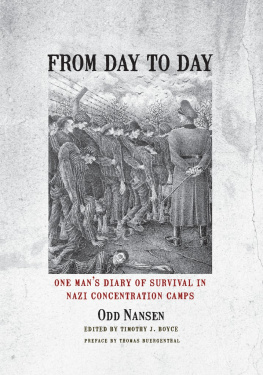Introduction, annotations, and appendixes 2016, Timothy J. Boyce
Preface 2016, Vanderbilt University Press
Illustrations by Odd Nansen used courtesy of Marit Greve
Published by Vanderbilt University Press
Nashville, Tennessee 37235
All rights reserved
First printing 2016
This book is printed on acid-free paper.
Manufactured in the United States of America
Library of Congress Cataloging-in-Publication Data on file
LC control number 2015042213
LC classification number D805.G3 N3513 2016
Dewey class number 940.53/18533154dc23
ISBN 978-0-8265-2100-2 (cloth)
ISBN 978-0-8265-2102-6 (ebook)
INTRODUCTION
by Timothy J. Boyce
I. ODD NANSEN
On a bitterly cold night in mid-January 1942, Odd Nansen listened, with some trepidation, to an ominous knock at the cabin door. He had good reason to be concerned. Nansen and his family, on an extended Christmas holiday in the snowy mountains above Lillehammer, had just tuned in their (illegal) radio to the (highly illegal) BBC Norwegian broadcast. The distinctive musical prelude, the da-da-da-dum of Beethovens Fifth Symphony (Morse code for the letter V for victory) had just resounded through the small hut. As it turned out, the timing of the three men who appeared at the door (the district sheriff and two Germans) was entirely coincidental; they suspected nothing. Rather, Nansen was merely asked to come to nearby Lillehammer and then Oslo, where he would be told the reason for the summons. While any such visit in occupied Norway was worrisome, Nansen was probably not overly concerned; he had been called in a year earlier by the Gestapo for questioning and released. It is unlikely he could have imagined at the time that he would not again experience freedom for some three and a half years, until the closing weeks of the war. It is even more doubtful that Nansen could have conceived on that fateful night the circles of hell he would travel before winning that freedom.
Nansens first night in captivity, after all, began innocently enough. Dinner in the Lillehammer jail, he recorded, was a lordly meal, consisting of beef olives, cakes, and cloudberries and cream, all topped off by half a bottle of burgundy. By the spring of 1945 and his imminent rescue at the hands of the Swedish Red Cross, however, his surroundings had become an infernal vale of tears and a sink of degradation, filled with wretchedness and horror. Nansen wondered whether anyone would believe this when we come to describe it. Indeed he was even unsure he could adequately describe all that he had seen and heard; it was so horrible, so incomprehensible in ghastliness, that it defies all description. What occurred during those three and a half years, between that first, rather comfortable night and his final, agonized deliverance, is the stuff of his diary, From Day to Day: One Mans Diary of Survival in Nazi Concentration Camps, one of the most vivid, horrifying, and humane documents to emerge from World War II.
Nansen was one of approximately forty thousand Norwegians held by the Nazis in prisons and concentration camps in Norway, Germany, and elsewhere during World War For in Norway the Nansen name was better known, and probably more highly regarded, than almost any other.
Odd Nansens father, Fridtjof Nansen, was a world-class athlete and a pioneering marine biologist. But it was as an intrepid explorer that Fridtjof Nansen secured his place in Norways pantheon. By the end of the nineteenth century only the polar regions remained unexplored, unmapped, unknown, as alluring and unknown as the surface of Venus or Mars, in the words of one writer.
Fridtjof Nansen burst upon the scene in 1888, when at the tender age of twenty-six, he became the first man to successfully cross Greenland, an island 80 percent covered by an ice cap more than a mile thick in places. The route Nansen chose, from the uninhabited and inhospitable eastern shore to the inhabited western, appealed to Nansens sense of daring; once launched he either had to reach his goal, and safety, in the west or perish in the attempt. There was no turning back.
Five years later, in 1893, Nansen (still only thirty-one) again ignored prevailing wisdom in his quest to reach the North Pole. He purposely allowed his specially constructed ship to become trapped in the ice; as that ice slowly drifted westward with the current (as Nansen theorized it would) his ship would drift to ever-higher latitudes. Again this plan meant there would be no line of retreat, no fallback plan. Again the lack of a Plan B was intentional. As Nansen once explained, Then one loses no time in looking behind, when one should have quite enough to do in looking aheadthen there is no chance for you or your men but forward. You have to do or die!
When Nansen finally returned, almost forty months after setting out, [h]e was like someone returning from the dead, And it was only natural, when Norway next desired to negotiate a neutrality treaty with the worlds then only superpowerGreat Britainthat Nansen was named Norways first ambassador to the Court of St. Jamess.
Now financially independent from book and speaking royalties describing his feat, Fridtjof Nansens reputation would have remained forever secure had he then simply retired to his newly constructed estate on the outskirts of Oslo, which he christened Polhgda, or Polar Heights. With the end of World War I (in which Norway had remained neutral), however, Nansen was approached by the newly created League of Nations. Determined to prove its relevance, the league engaged Nansen to organize the repatriation of POWs stranded in Germany and Russia. After all, according to one historian, he was unquestionably the most towering personality of the post-war world. His assent would prove to be a career pivot that would have dramatic ramifications for the remainder of his life, as well as the worldview of his son Odd.
Fridtjof brought to his new task the same single-mindedness that had characterized his life as an explorer and statesman. Soon he was also leading efforts to alleviate famine in Russia (assisted by a highly regarded young Norwegian named Vidkun Quisling), helping stateless refugees of the Russian Revolution, mediating claims of ethnic cleansing between the Greeks and the Turks, and seeking a homeland for the Armenians. In 1922 Fridtjof received the Nobel Peace Prize in recognition of his various humanitarian accomplishments. The Nansen Refugee Award, named in his honor, was instituted by the first UN high commissioner for refugees in 1954; it is awarded annually in recognition of the recipients extraordinary service to refugees.
Odd Nansen was born December 6, 1901, the fourth of five children of Fridtjof and Eva (Sars) Nansen. If Fridtjof was a national hero, Evas family boasted an equally distinguished pedigree. Her father was a highly regarded marine biologist, and her mother, Maren Welhaven, hosted a sophisticated and cultured salon; Marens brother, Johan Sebastian Welhaven, has been described as the first poet of consequence in the Norwegian language. which was unflattering and no doubt true, but entirely understandable; Eva, the baby of the family, was after all her nineteenth child.










